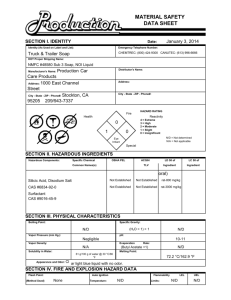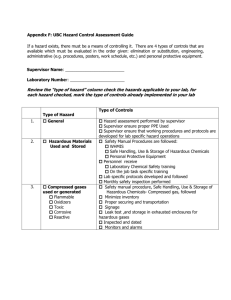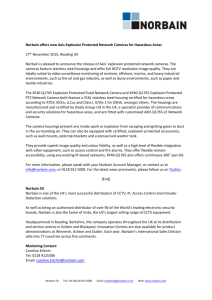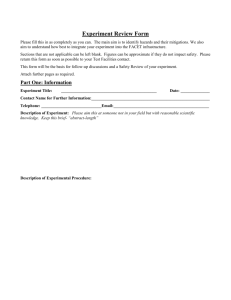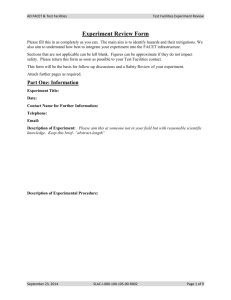SOP - SLAC
advertisement
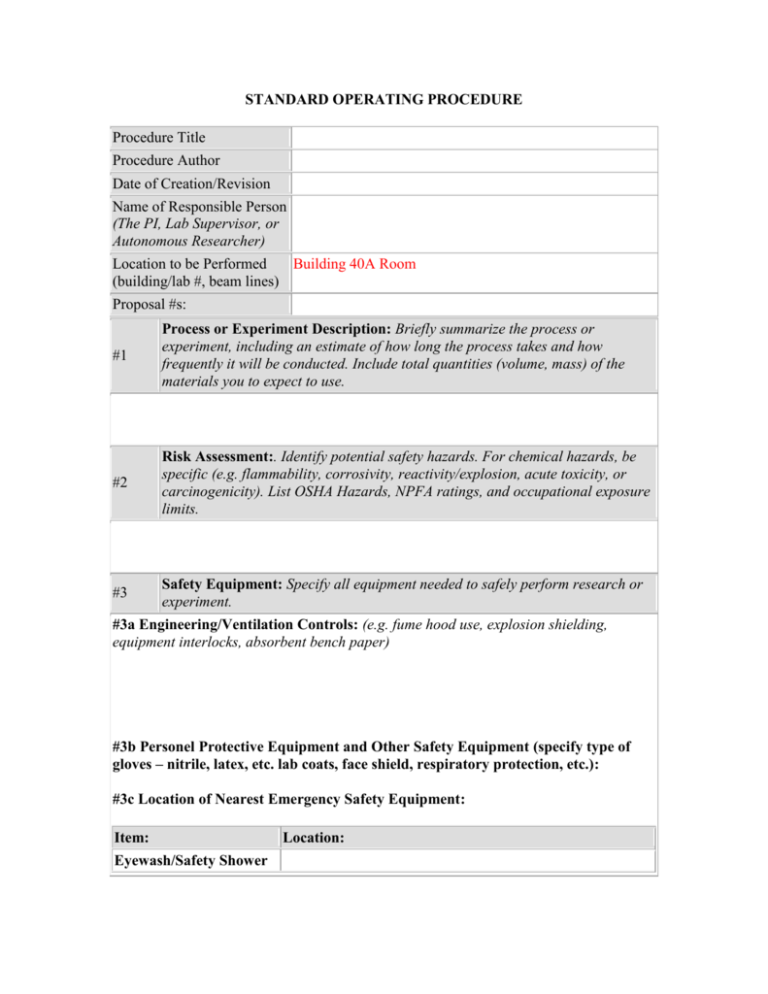
STANDARD OPERATING PROCEDURE Procedure Title Procedure Author Date of Creation/Revision Name of Responsible Person (The PI, Lab Supervisor, or Autonomous Researcher) Location to be Performed Building 40A Room (building/lab #, beam lines) Proposal #s: #1 Process or Experiment Description: Briefly summarize the process or experiment, including an estimate of how long the process takes and how frequently it will be conducted. Include total quantities (volume, mass) of the materials you to expect to use. #2 Risk Assessment:. Identify potential safety hazards. For chemical hazards, be specific (e.g. flammability, corrosivity, reactivity/explosion, acute toxicity, or carcinogenicity). List OSHA Hazards, NPFA ratings, and occupational exposure limits. #3 Safety Equipment: Specify all equipment needed to safely perform research or experiment. #3a Engineering/Ventilation Controls: (e.g. fume hood use, explosion shielding, equipment interlocks, absorbent bench paper) #3b Personel Protective Equipment and Other Safety Equipment (specify type of gloves – nitrile, latex, etc. lab coats, face shield, respiratory protection, etc.): #3c Location of Nearest Emergency Safety Equipment: Item: Eyewash/Safety Shower Location: First Aid Kit Chemical Spill Kit Fire Extinguisher Telephone Fire Alarm Manual Pull A fire alarm pull station is located outside the laboratory Station at the building exit. #4 Shipping and Receiving Requirements: Describe shipping or receiving requirements, especially for highly toxic, highly reactive/ unstable materials, highly flammables, and corrosives. . #5 Designated Area: Where highly toxic materials,, highly flammable/pyrophoric, highly corrosive, reactive/unstable, or nanomaterials are used, identify the designated work area(s), and the necessary personnel decontamination after completion of work. N/A #6 Step-By-Step Operating Procedure: Provide a sequential description of work, including details such as chemical concentrations and when special safety equipment is to be utilized. Include temperature, pressure, and other experimental conditions. Schematics, or pictures are suggested for complex set ups. #7 Special Handling Procedures, Transport & Storage Requirements: Describe special handling and storage requirements for hazardous chemicals in your laboratory, especially for highly reactive/ unstable materials, highly flammables, and corrosives. Describe transport and secondary containment requirements, between the laboratory and beam lines or between facilities. #8 Beam Line Handling and Storage Requirements: Describe sample handling procedures and sampling set up at the beam lines. Are samples sealed or open? Is ventilation required? Are heating, cooling, or gas distribution systems present? N/A #9 Emergency Procedures: Indicate how spills, personnel exposure/ injury, and other accidents should be handled and by whom. List emergency contact numbers. Safety Shower/Eye Shower: Any serious chemical self-contamination. Evacuate the Lab, and call 911 if: 1. Serious chemical self-contamination 2. Large hazardous material release. 3. Smoke, chemical fire, explosion. Call x5555 if: 1. Non-life threatening injury 2. Non-life threatening chemical or radiation incident. Additional Emergency Procedures: #10 Waste Disposal: Identify amounts of waste anticipated and appropriate disposal procedures. Waste will be segregated by hazard class (e.g. flammable, corrosive) and state (e.g. solid, liquid), appropriately labeled, and placed in the laboratory’s hazardous waste cabinet. Additional Waste Guidelines (please specify waste containers in the lab and which ones will be used for what waste) #11 Training Requirements: List the general and lab-specific trainings required. Please list all training courses. Additional Training Requirements: N/A #12 Approval Required: Identify any tasks that require prior approval by the PI/ Laboratory Supervisor (e.g., use of Restricted Chemicals and other higher hazard chemicals, and running of higher hazard operations). List Subject Matter Experts (SMEs) consulted for approval. Procedures must be approved by Laboratory Manager and Directorate Safety Coordinators. Additional Approvers: N/A Approved by: Approval date: Approved by: Approval date: Approved by: Approval date: Approved by: Approval date:
